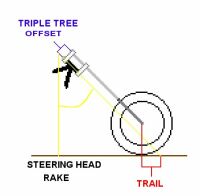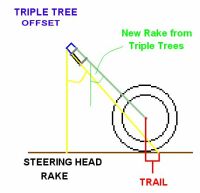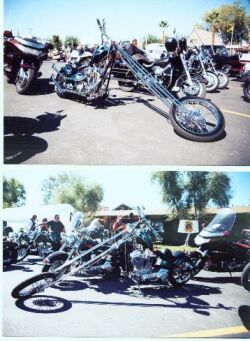 Customarily
Minded: August 2003 Customarily
Minded: August 2003 |
by Richard
Rose
Associate Editor
Beginner Bikes Magazine
 Frame
Geometry 101 Frame
Geometry 101 |
Welcome to this month's installment of Customarily Minded. This
month we'll look at a topic many of us slept through in school:
geometry. Specifically front end geometry concerning motorcycles.
For those that have been here at Beginner Bikes for a while, you
may have read some of my mumbo jumbo concerning frame geometry.
For those just joining us, and for those of you that have been mulling
over motorcycle specifications in magazines or websites and/or simply
just wondering what the heck those two terms mean, this article
will deal with the subject of rake and trail, and what it means
in the real world for your decision on your next motorcycle purchase.
So strap on that DOT approved thinking cap and let's get right to
the heart of the matter.
First off we'll look at rake. Rake (also known as Castor Angle)
is the angle of the steering head (and consequently the forks as
well as on most bikes they are parallel) in relation to a perpendicular
line going from the ground through the steering head. See the yellow
lines in Illustration 1. A steeper angle yields a shorter wheelbase,
a larger angle yields the chopper-esque longer wheelbase. Of course
the frame/swingarm design also has a lot to do with the wheelbase,
but the angle of the front end will ultimately seal the final figure.
Wheelbase will ultimately determine how much lean a motorcycle requires
to handle a turn at a given speed. Take two different bikes regardless
of weight and power into the same curve at the same speed, the one
with the longer wheelbase will have to lean at a greater angle than
the shorter wheelbased model in the curve. This means a 250 Rebel
with its diminuative 57.1" wheelbase will be able to take "Deadman's
Curve" at a speed of 45mph with a 25º lean, a Vulcan Mean
Streak with it's massive 67.1" wheelbase would take the same
curve at the same speed butwith a sharper lean of 30º (these
figures are simply for reference concerning this imaginary situation)
This means that the faster both bikes go, the Vulcan will be dragging
parts sooner than the Rebel as it will be leaning more to maintain
the same speed as the Rebel in the same curves (further proof of
the falacy concerning "outgrowing a beginner bike"). This
is why sport bikes have shorter wheelbases by design than cruisers,
it enables them to take curves at higher speeds.
Next up is trail. Trail is a somewhat confusing concept. The measurement
itself is taken by drawing an imaginary line through the steering
axis to the ground (angled yellow line in Illustration 1). Next
drop a perpendicular line from the front axle to the ground, which
in any production motorcycle should fall some distance behind the
point where the steering axis line touches down. The distance between
these two points is your trail dimension (see the red portion of
Illustration 1). Trail ultimately defines the handling characteristics
of a motorcycle, how stable it will be at higher speeds, how easy
it will flick through S-curves, and how easy it will be to control
at sub idle parking lot maneuvers. Bikes with a short trail will
be real easy to handle at slow speeds and quite responsive when
the road gets occupied with esses, but at higher speeds these bikes
will respond more to the road conditions and feel a bit twitchy.
On the other side of the coin, bikes with longer trail dimensions
may handle like a wheel barrow in the parking lot, require a bit
more encouragement to tackle an S curve, but track straight and
true like an arrow at freeway speeds, offering little response to
the road until the handlebars are activated by the rider. The trick
for the motorcycle designer is to find some happy medium for the
bike he/she is designing, something that will match the role the
bike is intended for.
Do rake and trail go hand in hand with each other? Typically bikes
with greater rakes have longer trail dimensions. However, the design
of the triple trees is what eventually defines the trail dimension.
Offset is measured by drawing an imaginary line from the center
of one fork tube to the other, then dropping a perpendicular line
from the center of that line to the center of the steering stem.
The distance of this perpendicular line is the triple tree offset.
What this does is position the front axle to a point where the trail
can be made to a suitable position. This means that the closer the
forks are to the steering stem the longer the trail can be modified,
as the axle is being positioned further back from the steering axis
to ground contact point. The farther apart the forks are from the
steering stem the shorter the trail.

Illustration
1: Note the three color coded measurements, yellow for rake, red
for trail, blue for offset.
Now
then, with all this in mind let's look at two different motorcycles
that are compatible in terms of size and weight, Kawasaki's 500cc
Vulcan and Honda's 600cc Shadow VLX. The Vulcan tips the scales
at 439 pounds (dry weight), has a 62.7" wheelbase, and sports
a 33º rake and 5.9" trail dimension. The Shadow weighs
in at 439 pounds dry (or 445 with the chrome Deluxe package), stretches
out to 63.2" in wheelbase, and has a 35º rake/6.5"
trail dimension.
Without riding either one, we can presume the following handling
characteristics based on what we now know about rake and trail:
The Vulcan should be able to negotiate slow speed maneuvers with
relative ease over the VLX thanks to a shorter trail, and at the
same time it should be able to handle curves and corners slightly
faster than the VLX as it won't lean over as far at any given speed
due to its half inch shorter wheelbase. The Vulcan also shouldn't
require as much force to negotiate an S-curve. On the freeway leading
out of town, take both bikes up to the posted 75mph speed limit
and the VLX will handle better as its longer trail dimension offers
better stability at higher speeds than the Vulcan. I've ridden both
machines and can attest that these theories are in fact true.
As you can see, a motorcycle's handling characteristics are yet
one more design that is of a give and take nature. Just like a larger
more powerful engine consumes more fuel over a less-peppy smaller
engine that conserves fuel, so it is with rake and trail. You just
can't have it all.
One trick that is being performed these days is the use of raked
triple trees. Some manufacturers are beginning to utilize this design
from the early days of choppers to make their bikes easier to handle.
Harley Davidson is one example, their new liquid cooled V-Rod sports
a most generous 38º rake (the largest OEM rake available currently).
Harley was shooting for the dragster look in the V-Rod style wise,
and if you've seen pro dragster motorcycles they have some serious
rake (and trail) in order to maintain stability at the higher speeds.
However, with that greater rake comes a longer wheelbase and a higher
trail dimension (depending on the triple tree offset), and Harley
wanted this bike to be a decent handler as well as a rocket. The
engineers at Harley opted for the raked triple trees. A raked triple
tree is designed such that the lower tree sticks out slightly more
than the upper tree, thereby creating a greater rake on the forks
in relation to the steering head. Harley used a +3º triple
tree on the V-Rod, added to their 35º raked frame to get the
new 38 degrees of rake. Like a longer offset measurement, the raked
triple tree positions the front axle closer to the steering axis
to ground contact point, all the while retaining that cool drag/chopper-esque
extra rake. I believe Honda utilizes the same trick on the 750 Shadow
Spirit (although the Spirit's final rake is 34º). In the end,
the sub-big bike sized 1130cc V-Rod has a trail dimension that measures
a crisp 3.9 inches, very close to most sport bike measurements.
Coupled with more horsepower than the Japanese big bore V2 powered
musclebikes that sport 4.5" to 6" trails, the V-Rod simply
mops the floor with them all around. As Jedi Master Yoda said in
the Empire Strikes Back, "Size matters not." 
Illustration 2: Note the shorter trail dimension on this diagram
(same scale as Illustration 1) with raked trees.
Okay
I know what may be going through your mind right now. I have a cool
cruiser and I want to make it into a cool chopper. So I'll just
rush right out and grab up a pair of raked triple trees for it,
not only will it give me some of that cool looking extra wheelbase
it will also help my handling. Wrong. It just isn't that simple.
For starters you need to know what your base rake and trail dimensions
are before even contemplating a chopper. Just because something
looks good in a magazine doesn't automatically mean that it will
work on your bike. The killer showbikes seen in Street Chopper and
other magazines have been carefully researched long before the first
wrench was turned during assembly. Because if you end up with too
short of a trail dimension, you get what is known in the chopper
world as a "bar slapper." Meaning as you get going faster
and faster, the front wheel becomes more unstable until the point
where the handlebars start slapping the tank. Chopper builders add
raked trees to their raked frames to shorten the trail. Add raked
trees to a stock frame and you guessed it, the trail gets shortened.
Chopper builders do it and get away with it because a raked frame
already yields a longer trail, making it shorter benefits them.
Make a shorter trail even more short and it can cause more harm
than good. There is a very fine line amongst frame position, frame
rake, triple trees, and fork length that defines how a chopper will
handle. If you don't do the research and just start throwing things
together from aftermarket catalogs, you could end up with a Franken-bike
sporting an unholy handling pact that can bite back.
So with all this in mind, next time you're browsing the spec pages
of a given motorcycle and you come across the rake and trail info,
you'll begin to get a better idea how said bike will handle without
even riding it. And when you do ride it you'll have a better idea
of what to expect. Once again to summarize it all: bikes with longer
rake and trail dimensions can be expected to be quite stable on
the freeway but will feel more sluggish in curves and slow speeds,
those with shorter rake and trail will be easier to control at slow
speeds and in the curves but will feel more twitchy on the freeway.
That wraps up this month's edition, and unlike other geometry classes
there will be no quiz on this material aside from your experiences
and discoveries during the upcoming ride. Keep your knees in the
breeze.
When associate editor Richard Rose isn't drawing imaginary lines
through his motorcycles, he answers email at rich@beginnerbikes.com. |
 Bike
Of The Month Bike
Of The Month |
This month's featured bike is an over exaggerated depiction of rake
and trail. This machine was designed and built at Denver's Choppers
in Las Vegas (yes, the same chopper company that was started by
the late Denver Mullins in California). It features an EVO powered
rigid frame built by Denvers, upswept fishtail exhaust, and DC's
second longest front end ever fabricated, a whopping 30" over
springer. That's a lot of flex in that front end too, you should
see it when the owner grabs a handful of throttle, it'll leave you
wondering if the springer mechanisms are actually ever in use. I
was offered a ride on it a couple years ago at a rally by the owner
(who worked at Denvers at the time) but I make it a personal policy
to turn down offers for rides on $45,000 motorcycles...

|

